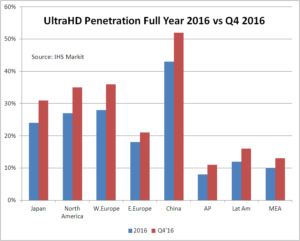 IHS Markit put out a press release highlighting that the UltraHD TV market will be dominated by China which is expected to take 42% of all the UHD TVs in 2017. The data was included in a white paper that was released in advance of the Cable Congress 2017. China took 25 million units in 2016 but that will almost double to 44 million in 2017 and that is the same as the next two regions (Western Europe and North America) combined.
IHS Markit put out a press release highlighting that the UltraHD TV market will be dominated by China which is expected to take 42% of all the UHD TVs in 2017. The data was included in a white paper that was released in advance of the Cable Congress 2017. China took 25 million units in 2016 but that will almost double to 44 million in 2017 and that is the same as the next two regions (Western Europe and North America) combined.
However, Western Europe and the US will both see more growth in percentage terms in 2017 as they will both take more than double the number of 2016. In Western Europe, more than 8 million 4K TVs shipped in 2016, forecast to increase to 19 million in 2020, while North American shipments are forecast to grow from 11.7 million in 2016 to 25.9 million in 2020.
 “China is on a different trajectory to the rest of the world when it comes to 4K TVs,” said Paul Gray, principal analyst, IHS Markit. “It is getting hard to buy a large screen TV in China without 4K. Japanese set makers also aggressively switched to 4K product ranges, especially in their domestic market, but shipments in Japan remain constrained by consumer preferences for screen sizes too small to support 4K.”
“China is on a different trajectory to the rest of the world when it comes to 4K TVs,” said Paul Gray, principal analyst, IHS Markit. “It is getting hard to buy a large screen TV in China without 4K. Japanese set makers also aggressively switched to 4K product ranges, especially in their domestic market, but shipments in Japan remain constrained by consumer preferences for screen sizes too small to support 4K.”
“Aggressive competition in the LCD display industry is fueling a pixel race,” Gray said. “Panel makers have added 8K resolutions to their road maps and product plans, a process that will accelerate as new Chinese LCD fabs start production.”
However, the IHS Markit white paper highlights a few challenges for 8K. The high pixel density demands that either a very large screen or short viewing distance is necessary.
China will dominate 8K shipments as its early-adopting consumers are likely to be eager for new features. 65″ will be the dominant 8K size, driven by affordable pricing in China. While Japan is planning 8K broadcasts from 2020, for most regions 8K video content will remain scarce for the foreseeable future.
IHS gave us this data on UltraHD Penetration. Source:IHS Markit
IHS Markit gave us the data above on the difference in penetration of UltraHD sets for the year as a whole and for Q4. Now, the TV business rarely moves very rapidly, so the difference really shows. Paul Gray, a veteran of the TV market and someone who understands the inate conservatism of many TV buyers, told us that the result is ‘incredible’. The success of UltraHD was helped, somewhat, by shortages of 32″ panels that pushed some buyers to larger sets. He also gave us the data below, which looks at sets at just 40″ and above.
 IHS UltraHD Penetration in sets of 40 inch and above. Source: IHS Markit
IHS UltraHD Penetration in sets of 40 inch and above. Source: IHS Markit
The penetration is so high that it won’t be long before some regions could become, effectively, totally UltraHD, Gray believes.
Analyst Comment
The White Paper is pretty good with a wide range of information. It covers issues including HFR/HDR and WCG pretty well and also highlights the issues in the production chain. We display specialists tend to assume that video is like graphics. Graphics coming from a PC are, essentially, perfect in these days of digital interfaces, unless there’s a fault somewhere. However, video depends on the quality of the camera and the settings used, the processing and editing of the video and then how it was compressed and transmitted. It then has to be decoded and processed again. At any stage, quality can be lost. I’m reminded that when there was a lot of controversy about the response times of LCD, PDP and CRT, image quality maven, Ray Soneira, watched a lot of hours of broadcast HD, recorded on a PVR. When he saw some blurring, he re-wound the recording and watched again critically on each of the display types. In every case, the blurring was in the video coming from the broadcaster because of the decisions made at the camera or in production!
Now cameras are getting better, but commercial programmes rarely reach the levels of the demos shown by the EBU or others at trade shows! (BR)

